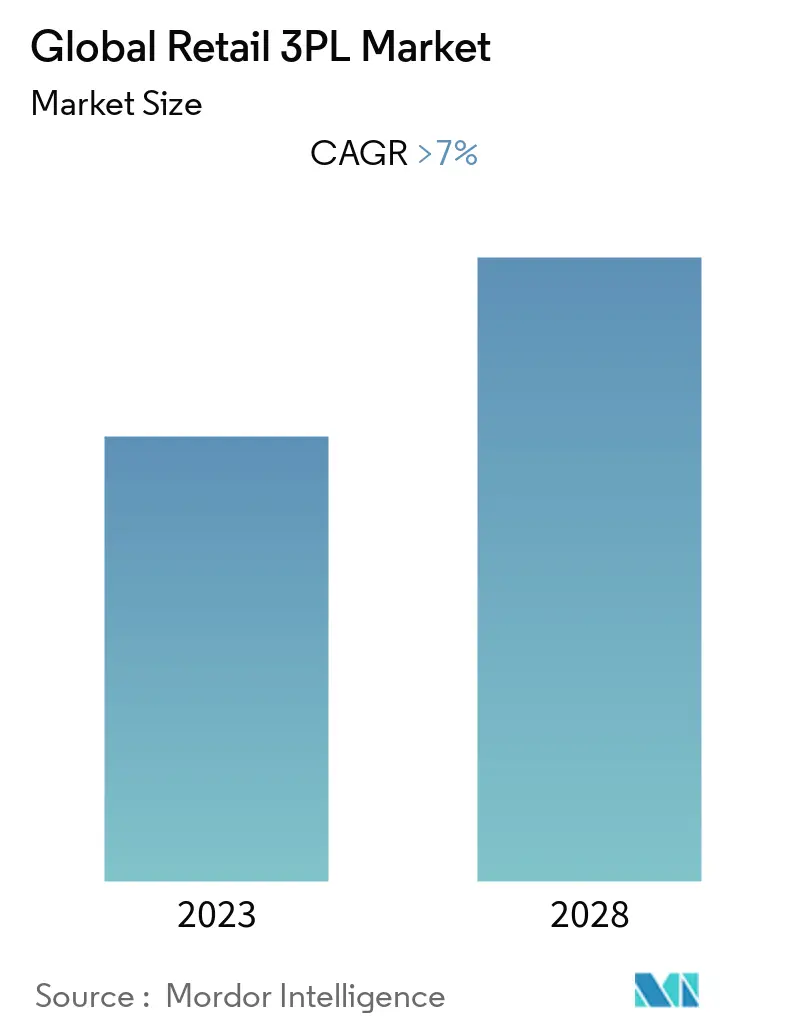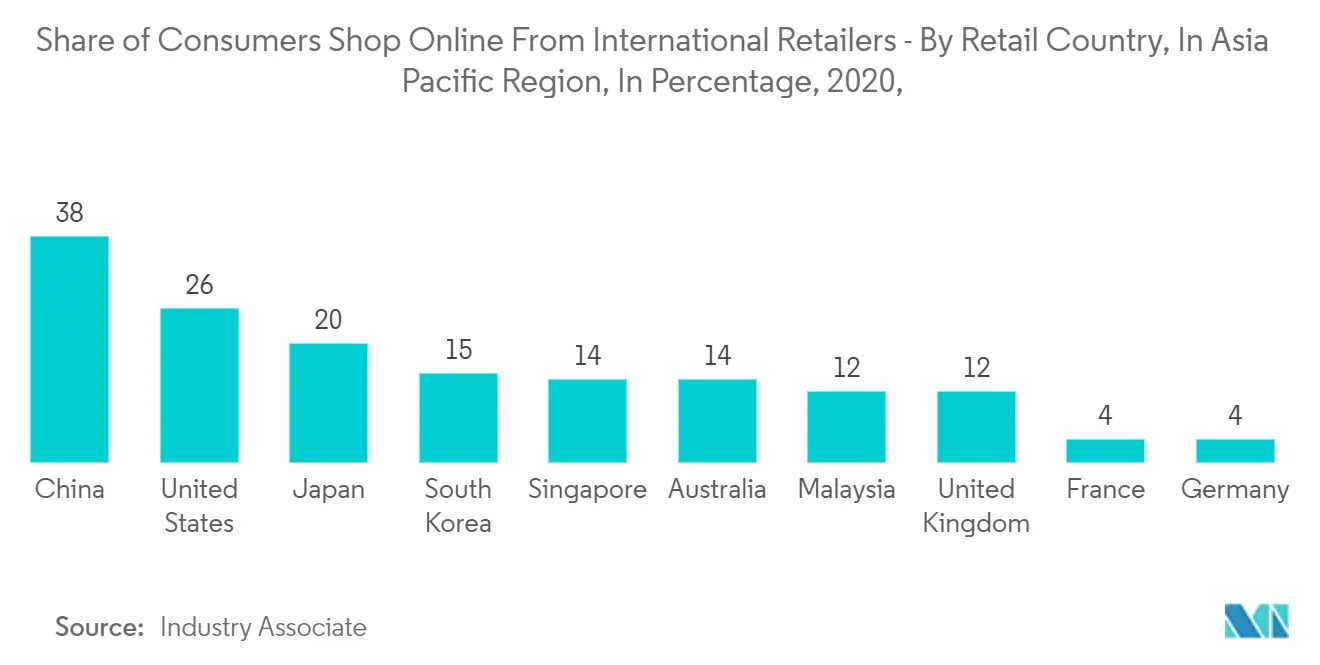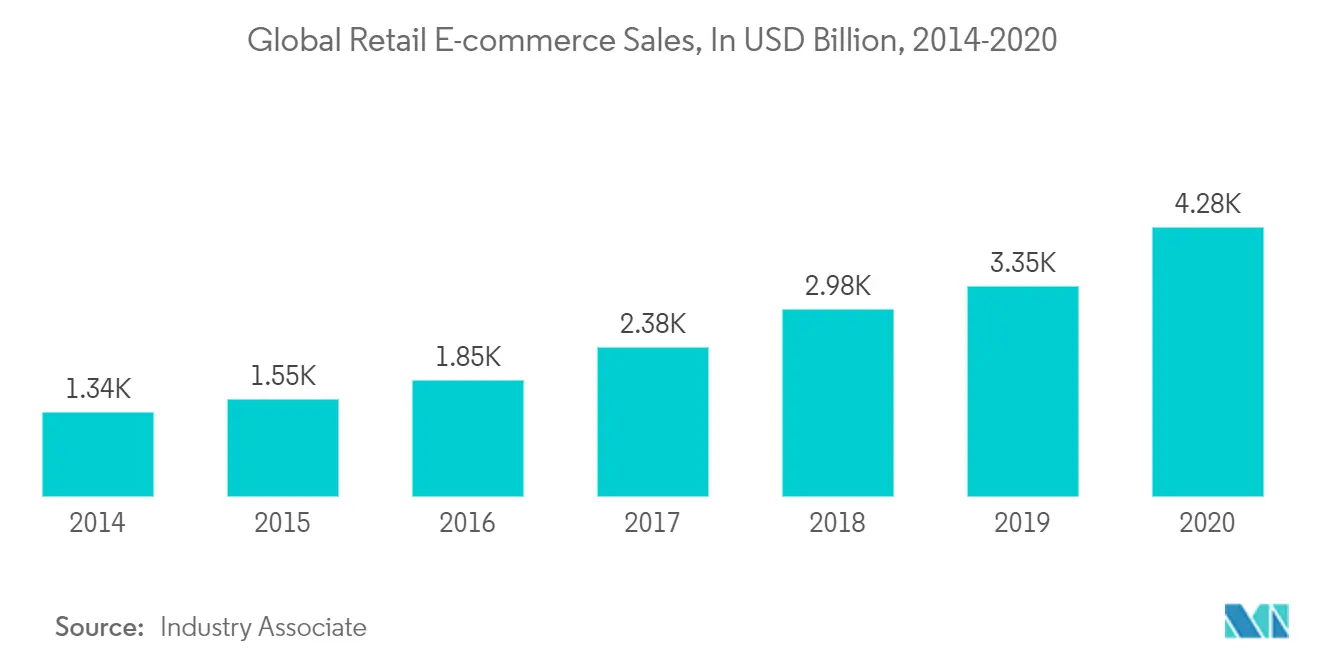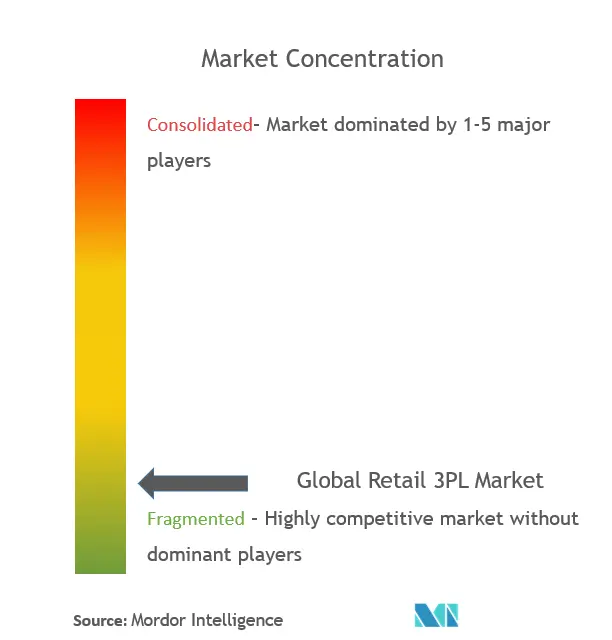Retail 3PL Market Size

| Study Period | 2019 - 2028 |
| Base Year For Estimation | 2021 |
| Forecast Data Period | 2024 - 2028 |
| Historical Data Period | 2019 - 2020 |
| CAGR | > 7.00 % |
Major Players
*Disclaimer: Major Players sorted in no particular order |
Need a report that reflects how COVID-19 has impacted this market and its growth?
Retail 3PL Market Analysis
The Global Retail 3PL Market is expected to register a CAGR of more than 7% during the forecast period (2022 - 2027). Third-party logistics organizations that deal with the transfer, storage, and movement of items have been directly impacted by the COVID-19 outbreak. Logistics companies help businesses get their products to customers both within and across international borders, facilitating trade and commerce. As a result of the pandemic, supply chain interruptions in the retail industry had an impact on competitiveness and economic growth. While the pandemic caused severe and unforeseen supply-chain disruptions at first, the crisis has also created opportunities for the logistics industry and its sub-services, such as cross-border e-commerce logistics. The pandemic hastened, and most likely irreparably hastened, the adoption of electronic commerce.
The Asia-Pacific was the largest region in the global retail market in 2020, accounting for 35% of the total sales. North America, the second-largest region, accounted for 29% of the global retail market. The Middle East was the tiniest region in the global retail business. Throughout Asia, the economy continued to improve in the first half of 2021, with growth seen in various markets. The first quarter of 2020 saw a 5% increase in FMCG spending in the APAC area, greater than the 3.4% increase seen in the first quarter of 2019. The food industry continued to lead market growth, increasing by a factor of two from 3.1% in Q1 2020 to 6% in 2021. The dairy category's growth rate increased significantly during the first quarter, rising to 5.1% from 2.4% the previous year. The beverages industry rebounded, recording value growth of 3.5% compared to a loss of -0.1% the year before, in keeping with the overall FMCG market's good performance. Non-food sectors, on the other hand, have seen a downturn in growth.
According to the European food retailers, emerging consumer trends in Europe moved in overdrive in 2020. Customers rushed to stock up on groceries at supermarkets and online during the first wave of the outbreak, while restaurants, companies, and schools were virtually shut down in most countries. Retail in Europe underwent extraordinary and dramatic developments in 2021. Companies, suppliers, and customers have not only had to cross an ocean of uncertainty as a result of COVID-19's upheaval, but they have also had to deal with massive shifts such as the stampede to omnichannel and the disruption caused by local crises such as Brexit. The European retail channel landscape continued to change and adapt to shifting consumer demands.
Retail 3PL Market Trends
This section covers the major market trends shaping the Retail 3PL Market according to our research experts:
Asia-Pacific Region Driving the Market
According to a 2020 industry report, 38% of Asia-Pacific consumers prefer to shop online with Chinese retailers. 4% of customers prefer to purchase at online stores based in Germany or France in the Asia-Pacific region. Asia-Pacific, which accounts for about three-quarters of the global growth, is driving the retail industry. It also gives the rest of the world a glimpse into the future through its digital innovation. Even though Asia-Pacific e-commerce had a stronger start, its growth was roughly double that of the rest of the world. People in APAC continued to migrate online in 2021 to access services that physical shutdowns have disrupted. In Southeast Asia alone, 20 million people became new digital users in the first half of 2021. Even as more offline locations emerged, customers who have become accustomed to the digital environment opted to stay online. In 2021, more than 58% of Indian and Chinese consumers purchased the majority of their products online rather than in stores.
The pandemic expedited the migration of sales from brick-and-mortar establishments to internet retailers. As indicated by the rising acceptance of online grocery shopping, it has also increased the demand for speedy and dependable delivery. In Asia-Pacific, only Australia and Japan (and to a lesser extent South Korea) have extended their physical retail networks to the same extent as their counterparts in the US and Western Europe. Outside of these territories, merchants in the region are witnessing enough online development that they are unlikely to expand their physical network to the same levels as those in the West.

Growth in E-commerce
Retail e-commerce sales worldwide reached USD 4.28 trillion in 2020, with e-commerce revenues expected to reach USD 5.4 trillion in 2022. One of the most popular internet hobbies in the world is shopping. E-commerce has grown at a rate of 15% each year on average over the last 10 years. It increased by more than twice that amount by 2020. E-commerce in the United States increased by 32% in 2020, to USD 790 billion, up from USD 598 billion in 2019. In the 2021 Christmas season, e-commerce sales in the United States grew considerably slower. From November to December 2021, US e-commerce sales increased by 11% over the same period in 2020, compared to a massive 47.2% growth in the Christmas season of 2020.
Latin America led the way in terms of e-commerce growth in 2021 (37%), followed by North America, Central and Eastern Europe, and Asia-Pacific. The two largest Latin American economies, Brazil and Mexico, are predicted to grow at a steady 30% per year by 2025, while newly emerging markets such as Bolivia, Guatemala, and Peru may accelerate even faster, with annual growth topping 40%. According to the industry analysis, the e-commerce development in Latin America is primarily due to two causes. First, the massive adoption of digital payment methods such as digital wallets and, in Brazil, PIX, which swiftly surpassed traditional payment methods like bank slips or TEDs, as the new favorite among Brazilians. Second is the widespread use of mobile commerce, whether via e-commerce apps or social media.
The e-commerce industry in the Middle East is growing. Consumers and businesses are increasingly turning to digital platforms, fuelled in part by pandemic lockdowns, with e-commerce sales predicted to reach USD 69.2 billion in 2020, up from USD 4.3 billion just four years ago. The UAE emerged as a regional leader, cementing its position as the Middle East's top e-commerce powerhouse during the pandemic. Saudi Arabia's e-commerce business is expected to reach USD 13.3 billion by 2025, following a 60% increase in 2019-2020 due to a digital upsurge that increased during the pandemic. The Kingdom has a higher percentage of online shoppers than the Middle East and African region's average of 73%. Saudi internet sales were only 8% of the overall retail sales, compared to the global average of 18% and the 30% to 40% posted by the world's leading e-commerce economies.

Retail 3PL Industry Overview
The global retail 3PL market is fragmented in nature with a mix of global and local players. Some of the strong players include DSV Panalpina, Ceva Logistics, Ryder Supply Chain Solutions, C.H. Robinson, and Hub Group. Despite the restrictions and lockdowns in place around the world, governments in 2020 allowed trucks to commute at night to meet the country's internal demands, causing severe disruption in the third-party logistics industry. As the market grew due to the development in e-commerce, new third-party logistics companies began to enter the market.
Retail 3PL Market Leaders
DSV Panalpina
Ceva Logistics
Ryder Supply Chain Solutions
C.H. Robinson
Hub Group
*Disclaimer: Major Players sorted in no particular order

Retail 3PL Market News
September 2021: Nippon Express (Taiwan) Co. Ltd, a local subsidiary of Nippon Express Co Ltd, established a new logistics base (NEXT3 Warehouse) in Taoyuan City in northern Taiwan in May and obtained business licenses for cosmetics, pharmaceuticals, and medical equipment.
March 2021: CEVA Logistics and Berkshire Grey are implementing AI-enabled robotic automation systems into CEVA’s supply chain operations in Canada. Embedding robotic solutions at CEVA’s Vancouver eCommerce facility will maximize distribution center capacity, optimize throughput, and accelerate fulfillment processes.
Retail 3PL Market Report - Table of Contents
1. Introduction
1.1 Study Deliverables and Assumptions
1.2 Scope of the Study
2. Research Methodology
2.1 Analysis Methodology
2.2 Research Phases
3. Executive Summary
4. Market Dynamics And Insights
4.1 Current Market Scenario
4.2 Market Dynamics
4.2.1 Drivers
4.2.2 Restraints
4.2.3 Opportunities
4.3 Value Chain / Supply Chain Analysis
4.4 Industry Policies and Regulations
4.5 General Trends in the Warehousing Market
4.6 Demand From Other Segments, such as CEP, Last Mile Delivery, Cold Chain Logistics, Etc.
4.7 Insights on E-commerce Business
4.8 Technological Developments in the Logistics Sector
4.9 Industry Attractiveness - Porter's Five Forces Analysis
4.10 Impact of COVID-19 on the Market
5. Market Segmentation
5.1 By Product
5.1.1 Foods and Beverages
5.1.2 Personal and Household Care
5.1.3 Apparel, Footwear, and Accessories
5.1.4 Furniture, Toys, and Hobby
5.1.5 Electronic and Household Appliances
5.1.6 Other Products
5.2 By Distribution Channel
5.2.1 Supermarkets/Hypermarkets, Convenience Stores, and Department Stores
5.2.2 Specialty Stores
5.2.3 Online
5.2.4 Other Distribution Channels
5.3 By Geography
5.3.1 Asia-Pacific
5.3.1.1 China
5.3.1.2 Japan
5.3.1.3 India
5.3.1.4 South Korea
5.3.1.5 Rest of Asia-Pacific
5.3.2 North America
5.3.2.1 United States
5.3.2.2 Canada
5.3.3 Europe
5.3.3.1 United Kingdom
5.3.3.2 Germany
5.3.3.3 France
5.3.3.4 Russia
5.3.3.5 Rest of Europe
5.3.4 Middle-East and Africa
5.3.4.1 Saudi Arabia
5.3.4.2 United Arab Emirates
5.3.4.3 Qatar
5.3.4.4 South Africa
5.3.4.5 Rest of Middle-East and Africa
5.3.5 Latin America
5.3.5.1 Chile
5.3.5.2 Brazil
5.3.5.3 Mexico
5.3.5.4 Argentina
5.3.5.5 Colombia
5.3.5.6 Rest of Latin America
6. Competitive Landscape
6.1 Market Concentration Overview
6.2 Company Profiles
6.2.1 DSV Panalpina
6.2.2 Ceva Logistics
6.2.3 Ryder Supply Chain Solutions
6.2.4 C.H. Robinson
6.2.5 Hub Group
6.2.6 D.B. Schenker
6.2.7 J.B. Hunt
6.2.8 Echo Global Logistics
6.2.9 UPS Supply Chain Solutions
6.2.10 U.S. Xpress Enterprises
6.2.11 Coyote Logistics
6.2.12 Nippon Express
6.2.13 XPO Logistics
6.2.14 DHL Supply Chain
6.2.15 Kuehne + Nagel*
- *List Not Exhaustive
7. Future of the Market
Retail 3PL Industry Segmentation
Third-party logistics, often known as 3PL, is a system in which a company offers inventory management and delivery services to another company. A 3PL company is frequently used by a company (client) that does not have its own logistics department. In turn, the 3PL takes care of some or all of the client's logistics needs. The global retail 3PL market is segmented By Product (Foods and Beverages, Personal and Household Care, Apparel, Footwear, and Accessories, Furniture, Toys and Hobby, Electronic and Household Appliances, and Other Products), Distribution Channel (Supermarkets/Hypermarkets, Convenience Stores, and Department Stores, Specialty Stores, Online, and Other Distribution Channels), and Geography (Asia-Pacific, North America, Europe, Middle-East and Africa, and Latin America). The report offers market size and forecasts for the Global Retail 3PL Market in Value (USD Billion) for all the above segments. It also covers a comprehensive background analysis of the Global Retail 3PL Market, covering the current market trends, restraints, technological updates, and detailed information on various segments and the industry's competitive landscape. The impact of COVID-19 has also been incorporated and considered during the study.
| By Product | |
| Foods and Beverages | |
| Personal and Household Care | |
| Apparel, Footwear, and Accessories | |
| Furniture, Toys, and Hobby | |
| Electronic and Household Appliances | |
| Other Products |
| By Distribution Channel | |
| Supermarkets/Hypermarkets, Convenience Stores, and Department Stores | |
| Specialty Stores | |
| Online | |
| Other Distribution Channels |
| By Geography | ||||||||
| ||||||||
| ||||||||
| ||||||||
| ||||||||
|
Retail 3PL Market Research FAQs
What is the current Global Retail 3PL Market size?
The Global Retail 3PL Market is projected to register a CAGR of greater than 7% during the forecast period (2023-2028).
Who are the key players in Global Retail 3PL Market?
DSV Panalpina, Ceva Logistics, Ryder Supply Chain Solutions, C.H. Robinson and Hub Group are the major companies operating in the Global Retail 3PL Market.
Global Retail 3PL Industry Report
Statistics for the 2023 Global Retail 3PL market share, size and revenue growth rate, created by Mordor Intelligence™ Industry Reports. Global Retail 3PL analysis includes a market forecast outlook to 2028 and historical overview. Get a sample of this industry analysis as a free report PDF download.
